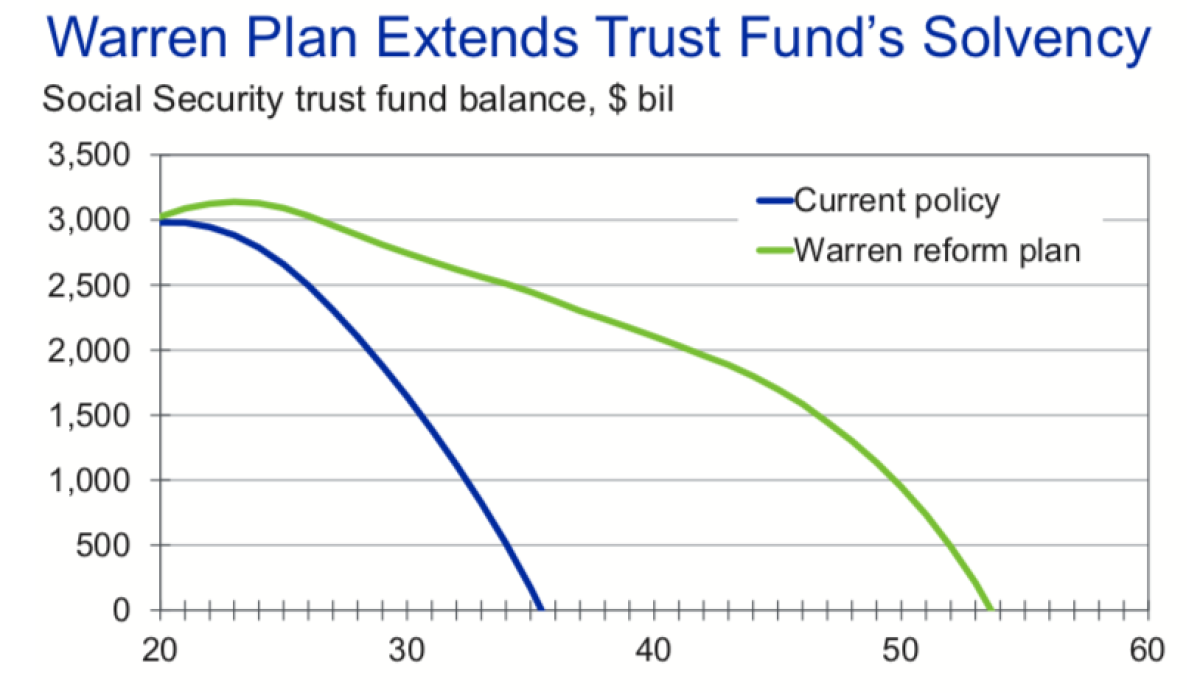Column: Elizabeth Warren offers a Social Security reform plan that checks a lot of boxes

- Share via
Congressional progressives lately have been putting forth Social Security reform plans that shore up the system’s finances while improving benefits. Sen. Elizabeth Warren (D-Mass.) on Thursday joined the march with a plan that offers more generous increases than the rival proposals, coupled with a stiffer tax bite on the richest Americans.
Warren’s plan, like the others, addresses many of the shortcomings long identified by the program’s advocates. On the whole, it’s a worthy addition to the discussion about how to provide for a more secure retirement for middle- and low-income Americans, while redressing some of the baked-in disadvantages for women.
More important, it’s a solid rebuff to Republicans and conservatives whose hand-wringing about Social Security leads to proposals to cut benefits. Warren’s entry into the lists as a presidential candidate ensures that the debate will take place in the public sphere — not, as Sen. Joni Ernst (R-Iowa) advocated recently, “behind closed doors.”
The crux of the conservative attack on Social Security in recent years has been the claim that the program is on an unbroken path to insolvency.
When Washington politicians discuss the program, it’s mostly to debate about whether to cut benefits by a lot or a little bit,” Warren wrote on Medium in introducing her plan. She tied it to the recent history of legislating handouts to the rich and trying to pay for them by cutting benefits for everyone else. “We need to get our priorities straight.”
Let’s look at the details of Warren’s plan and how they differ from two proposals introduced in Congress, the Social Security 2100 Act, introduced by Rep. John B. Larson (D-Conn.), and the Social Security Expansion Act, filed by Sen. Bernie Sanders (I-Vt.), who is one of Warren’s rivals for the presidential nomination, and Rep. Peter A. DeFazio (D-Ore).
All three proposals take aim at some of the same issues, such as the chronic shortchanging of women who spend their career years caring for dependents at home and the need to extract more tax support from the wealthiest Americans, but offer somewhat different solutions.
When Washington politicians discuss the program, it’s mostly to debate about whether to cut benefits by a lot or a little bit. We need to get our priorities straight.
— Sen. Elizabeth Warren (D-Mass.)
On the benefit side, Warren’s plan is the most generous of the three. She’d increase benefits by $200 a month across the board. That’s a larger increase than either of the two rival bills offer, would apply to everyone and would take effect immediately. The rival bills concentrate the increase among middle- and low-income workers and are phased in over time.
Retirement experts warn that an economic crisis is facing Americans who haven’t saved enough to maintain their lifestyles in retirement in part because rank-and-file wages have stagnated for decades as employer pension plans shrink. Warren told me by email, “63 million Americans rely on monthly Social Security benefits, but current benefits are too small for millions of them to support a decent retirement.” Her $200 monthly increase would “address the current retirement crunch — and looming retirement crisis — head on.”
Warren also takes aim at some gaps in Social Security benefits that have stuck in reformers’ craws for years. She would provide an earnings credit for caregivers of children under age 6, or disabled or elderly family members.
GOP Sen. Joni Ernst wants to ‘reform’ Social Security in secret, an indication that the public won’t like the result
This is important because mothers already are disadvantaged by Social Security since they’re likelier than fathers to take parental leave from their jobs, so they’re likelier to lose more retirement benefits and don’t receive Social Security work credits for the years they spend as caregivers in the home. Warren would provide a caregiver credit for each month of caregiving tied to a given year’s median annual wage for individuals.
Warren would also repeal the widely detested Windfall Elimination Provision and Government Pension Offset, known together as WEP/GPO. These little-known rules that apply to some 2 million workers were designed to keep state and local employees whose jobs were not covered by Social Security from getting excessive benefits from Social Security, either via their spouses’ Social Security benefits or their own earnings from private-sector jobs they held before or after their public employment.
The rules require those benefits to be reduced to offset their own public employee pension benefits. But they’re crude instruments that create a special burden for teachers and other public employees in states like California that don’t require all public workers to be in Social Security. Democrats have tried for years to ax the provisions, without success — in part because repeal would cost some $8 billion a year.
Warren’s plan would also restore the student benefit for full-time students 19 or older, a provision that was repealed in 1981, leaving benefits only for students in K-12 school up to the age of 18. She would expand the benefit to students up to age 24, going slightly better than Sanders, who would restore it for survivors up to age 22.
Like Larson and Sanders, Warren would mandate that cost-of-living increases be tied to an inflation index that better reflects the living costs of seniors than the standard CPI in use today.

The alternative index, known as the CPI-E, gives greater weight to expenses such as healthcare, which tend to play a larger role in seniors’ budgets. According to an analysis done for the Warren campaign by Mark Zandi, chief economist at Moody’s Analytics, the change would increase the annual cost-of-living adjustment for benefits by an average of about 0.2 percentage point a year.
On the revenue side, Warren would immediately boost the payroll tax on wealthier Americans by applying a 14.8% tax on wage income over $250,000 a year. Currently, the payroll tax is 12.4%, split between employers and employees, up to an inflation-adjusted wage ceiling (this year, $132,900).
Warren’s $250,000 threshold wouldn’t change with inflation, so the tax-free gap would shrink until the taxable maximum reached $250,000, which Zandi projects would happen in 2037. Wages under the taxable maximum would still be taxed at 12.4%, even after it reaches $250,000.
Warren also would bring investment income into the Social Security tax system. That’s an important change, because the exclusion of unearned income from the tax enables wealthier Americans, who get much more of their income from capital gains, dividends and interest than middle- or low-income Americans, to pay a much lower tax rate to support the program. Warren’s plan would apply a 14.8% tax on investment income for households with income over $400,000 for couples and $250,000 for individuals.
The most significant difference between Warren’s plan and the other Democratic proposals is that hers would extend the life of Social Security’s trust fund — its surplus, so to speak — by an estimated 20 years, to 2054. The latest guesstimate of the Social Security trustees is that the trust fund will run out in 2035; at that point, barring congressional action, benefits would have to be cut by as much as 25%.
By contrast, Larson’s bill would extend the trust fund surplus for at least the standard 75-year horizon used in Social Security projections, and effectively permanently, and the Sanders bill by more than 50 years.
Warren’s extension is shorter chiefly because her plan offers more generous benefits to all Social Security recipients, even though she would implement tax increases more swiftly than the other plans.
More to Read
Inside the business of entertainment
The Wide Shot brings you news, analysis and insights on everything from streaming wars to production — and what it all means for the future.
You may occasionally receive promotional content from the Los Angeles Times.












